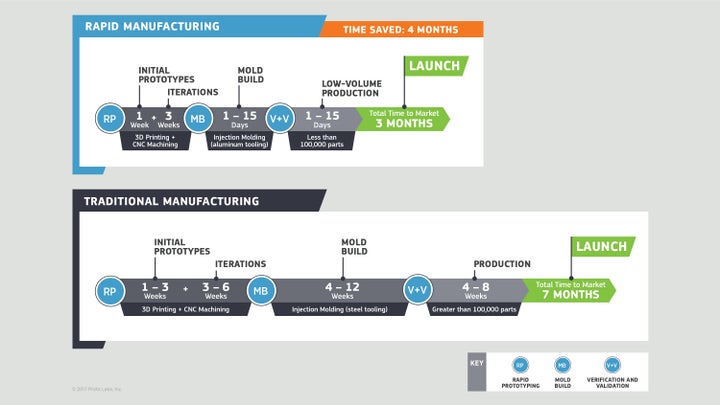Much has been said about the potential of digital manufacturing, the notion of weaving software throughout manufacturing processes for increased speed and efficiency. Business leaders want to know exactly how to leverage advances in technology to drive real business outcomes, especially in hyper-competitive markets where time-to-market can make or break your quarterly revenue targets.
Businesses in the medical device sector, for example, are using digital manufacturing to increase the rate of product innovation and to reduce development cycles, thereby reducing their R&D costs. Others are optimizing their supply chain by consolidating suppliers and reducing lead-times.
Ultimately, for businesses looking to operate more efficiently and competitively, digital manufacturing models have the potential to create tangible business results that can be realized from the factory floor all the way to the board room. Here are five examples.
1. Faster Time to Market
Faster time to market often means lower R&D costs and a quicker path to revenue, both of which have a very direct impact on the top and the bottom line.
Imagine if your development teams could reduce their development cycles by as much as 50 percent, allowing you to move from a product concept to a market-ready solution in half the time that you could before. What impact could this have on your financial performance? Digital manufacturing makes these achievements possible. We’ve seen them happen through our customers.

Rapid, on-demand manufacturing can take months out of product development when compared to traditional models.
Automated quoting in manufacturing, for example, allows designers to configure parts on their own in a digital environment. This can eliminate the back-and-forth calls with a salesperson and significantly shorten lead times during the parts-manufacturing process.
Interactive design for manufacturability (DFM) tools can give immediate analysis and feedback on part designs before they’re even manufactured. These tools can help digitally identify design issues that could create production challenges or require costly rework. Digital design feedback also can help shorten development cycles by days or even weeks, saving precious development resources.
In a digital manufacturing model, once a design is finalized, it can then seamlessly move along a digital thread into prototype and low-volume production.
2. Making the Economics of Customization Work
Product customization is already vital in industries like life sciences, where implants and prosthetics are designed for individual patients. But customization is also becoming the norm elsewhere. In the consumer-electronics industry, smartphones, fitness trackers, industrial equipment and other devices are now updated on an annual basis. Even seemingly standard objects in our kitchens and bathrooms are now frequently refreshed to meet consumer and retailer demands.

Prior to the arrival of digital manufacturing, product customization was out of the question for most companies. It simply wasn’t economical given the amount of upfront engineering costs that are required in traditional manufacturing models.
Today, however, the ability to digitize the development process puts customization within reach for any company. Digital manufacturing models, whether for injection molding, CNC machining or 3D printing, allow companies to economically produce lower volumes of a greater variety of parts to meet consumer demand.
In addition, being able to economically purchase low volumes of custom parts allows manufacturers to match supply of parts more directly to fluctuating demand of finished products. This reduces working capital and eliminates waste.
3. Reduced Design Risk
Developing a new product, or redesigning an existing one, almost always comes with some level of inherent risk. Will the new design be manufacturable? Will it meet my cost targets? Will it pass form, fit and function testing? Will it gain market acceptance?
These are the types of questions that development teams are tackling every day.
Parallel prototyping, the process of simultaneously creating multiple designs to fast-track the acceptance of one of them, is one way to reduce risk during the product-development phase. Digital manufacturing allows developers to prototype multiple designs quickly, thus reducing design risks and ultimately costs.
4. Improved Design Flexibility
Already today, many companies are using digital manufacturing technologies such as 3D printing to reimagine how they design their products. In doing so, they’re eliminating previous design constraints and enabling their engineers to design products for optimized functionality.
GE provides a good example with its new turboprop engine, the world’s first to use 3D-printed components. The company used 3D printing to consolidate 845 parts into 11 components. The reduction in complexity will help speed up production, reduce fuel burn up to 20 percent, achieve 10 percent more power and reduce overall weight, according to GE.
5. Lower Production Costs
Clearly, digital manufacturing is having a transformative impact on the product-development process. But it’s also helping companies produce low volumes of on-demand end-use parts in a cost-effective manner.

A digital manufacturing approach to end-use part production can shorten lead times and reduce procurement costs. It also reduces inventory costs because parts can be made on-demand, making minimum-order quantities a thing of the past. Now, companies can buy the exact number of parts they need, when they need them. This is also invaluable when product demand is difficult to predict.
Opportunities Abound
Examples of companies using digital manufacturing to improve their competitiveness are everywhere.
In the aerospace sector, Pratt and Whitney replaced its configuration management systems with a single CAD-driven data-management solution from Siemens to decrease product-development costs by 75 percent. Automaker Ford is using 3D printing to eliminate special tooling for parts that are likely to change, saving the company millions of dollars in product development.
The question now is, are you willing to seek out and seize on the opportunities that digital manufacturing offers to improve or differentiate your business? Or are you willing cede that task to your competitors? If you’re not sure where to begin, start by developing goals for where digital manufacturing can help you most.
